 |
Ecumenism
The Hand-Over of the Icon of Kazan:
A Triple Betrayal of the Catholic Church
Marian T. Horvat, Ph.D.
Published in Catholic Family News, October 2004
After repeated attempts to win a visit to Russia with the holy Icon of Kazan as a calling card and unfailing rebuffs from Russian Patriarch Alexis II, John Paul II gave in and handed over the holy Icon with “no strings attached.” That is say, no papal visit. Alexis II haughtily accepted the offer, all the while emphasizing the Pope was not welcome in Russia, downplaying the icon’s importance, and complaining about past and present imagined grievances.
In the name of improving dialogue, the Vatican swallowed the affronts. The Pontiff appointed a 10-member commission headed by Cardinal Walter Kasper - including American Cardinal Theodore McCarrick of Washington D.C. - to deliver the icon to the arrogant Alexis II on August 28.
A betrayal of Church’s Militant and Missionary characters
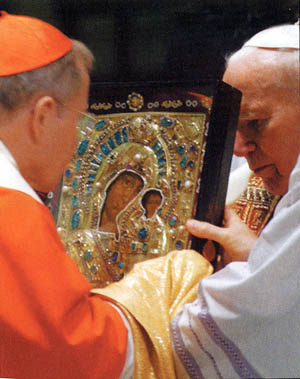
John Paul II delivers the Icon to Cardinal Walter Kasper, his personal delegate for the hand-over
Inside the Vatican, September 2004 |
The 13th-century miraculous Kazan Icon is one of the most popular devotions to the Virgin Mary in Russia. Because of her timely intercession for Russia in various battles, Our Lady of Kazan became known as the “protectress of Russia” and associated with the very destiny of Russia as a nation. Hence her symbolic value in the East.
In 1918, the Icon disappeared from Our Lady of Kazan Basilica in Moscow, but her story did not end there. It was found and purchased around 1970 by the Blue Army of Our Lady of Fatima with the intent of safeguarding it in Fatima until after Russia’s conversion, when it would be returned. The Kazan Icon thus took on a special symbolic value for the West also, linked to the Fatima prophecies. In 1993 the Blue Army gave it to John Paul II, and it remained in his private apartments for a decade until its return to the Kremlin last month (1).
1. For a full account of the Blue Army’s betrayal of their custodianship, see my article “Handing Over the Symbolic Icon of Our Lady of Kazan: A Confirmation of a Great Crisis in the Church.”
The situation has a certain irony. Russia has not converted. The “Orthodox” Church is weak and faltering, still controlled by the two ex-KGB agents, Alexis II and Kirill de Smolensk, with only some 2 to 5 percent of its members actually practicing. A natural opening exists for the conversion of the people to Catholicism. But far from taking advantage of this missionary opportunity, the Vatican has issued directives that the Catholic authorities in Russia do everything they can to prevent conversions in order not to offend the testy Schismatics, who constantly complain of “Catholic proselytism.”
This Vatican order was emphatically confirmed by the president of the Russian Bishops’ conference Archbishop Tadeusz Kondrusiewicz. “We serve the Catholics in Russia,” he stated in a recent interview, but “without any policy of proselytism [conversion]. I am against such a policy.” “I’ve repeated this 100 times,” he insisted, “so now let it be 101.” No conversions, with a “very big” no (2).
Asked about the Fatima message, the Archbishop gave the Vatican interpretation: “The Fatima message was not about making Russia a Catholic country.” This is, he stated, “absolutely wrong thinking.” After Vatican II declared that “Orthodox” churches have the same Sacraments and the same means of salvation, he argued, there is no need for such a policy [conversion.] “The Catholic Church was always a church of a minority, and will remain so,” he concluded (3). A clear denial of the missionary character of the Catholic Church.
This is not only his thinking, but also that of John Paul II. As progressivist journalist John Allen explained it:
“John Paul has made it clear that he believes the salvation of Russia will be through Orthodoxy, and that the future lies not in conversion but in communion – the Latin and Byzantine churches coming together as one family of faith, each preserving its legitimate autonomy”(4).
The progressivists use communion to stress their desired union of all the religions, ignoring that the false religions deny the true Faith (5).
On this quest for communion with the Schismatics, the decision was made to return the Icon of Kazan as a symbolic gesture of “unity between the East and the West.” The decision itself clearly confirms that John Paul II believes that Russia does not need to convert, and constitutes an implicit betrayal of the militant and missionary character of the Catholic Church. She should no longer fight against evil and no longer needs to convert anyone.
2. John Allen, Jr., “Interview with Archbishop Tadeusz Kondrusiewicz,” National Catholic Reporter Online, August 21, 2004.
3. Ibid.
4. “The Word from Rome,” in ibid., August 27, 2004.
5. For a clear exposition of the progressivist understanding of communion, see Atila S. Guimarães, Animus Delendi II, (Los Angeles: TIA, 2002), Part II, Chapter V.
A betrayal of the Fatima message
With the decision to deliver the icon sans Pope, the Russian Schismatics with the support of the Vatican launched another misleading maneuver: news began to spread that the Icon was “almost certainly not the original,” but a 17th-century copy. This statement contradicts a quite competent previous study. In fact, Vatican art experts had already stated positively that the Icon was the original 13th-century image of Our Lady of Kazan, the most venerated and copied icon in Russia (6).
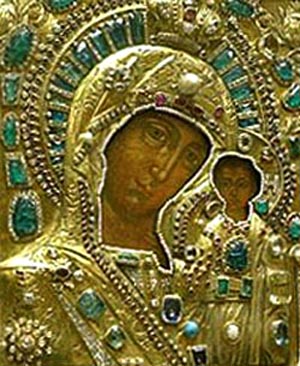
Even the Schismatics admitted the Icon's authenticity until their last maneuver to devalue JPII's gesture |
Also, it is significant to recall that on February 20, 2002, Metropolitan Kirill of Smolensk, number two man in the Russian Schismatic hierarchy, asked Interpol (global police agency) to seize the Icon of Kazan from the papal apartments. He charged that the Icon of Our Lady of Kazan had been “stolen” from the Russian Church. He asked the Interpol to recover it “by whatever means are necessary” (7). Therefore, Kirill, spokesman of the Schismatic Church, was obviously convinced that the Icon was authentic.
After that, however, and with no new data entering the picture, the Russians changed their mind and began to spread a rumor that it was not the original. The maneuver was interpreted by many as a mere ploy of the Schismatics pretending disinterest in face of the shameless insistence of JPII to personally deliver the Icon.
In April 2003 the Vatican published new results of a team of specialists delegated by the Russian Culture Ministry to examine the Icon. Their commission concluded precisely what the Russian Schismatics wanted them to conclude: the Icon was not authentic. Even though these results contradicted the previous verdict of impartial experts, the Vatican immediately agreed, most probably to “improve the dialogue” (8). I do not have a drop of doubt about the authenticity of the Icon. On the contrary, I profoundly doubt the authenticity of the recent analysis made by the Russian experts, since their findings serve the Russian interests to a tee.
Without blinking, the Catholic press adopted the latest Schismatic version of the story and began calling the revered Icon of Kazan “a copy.” For the Vatican, the new account was convenient and helped soften the blow to the Catholic public regarding the hand-over. For the Schismatics, it downplayed the significance of the “symbolic gesture.” There was no need for the Pope himself to bring the copy, since it was just “one of many copies,” as Alexis II offhandedly stated (9).
But this new story poses serious questions, noted Atila Guimarães in his article, “Kazan: The End of the Story” (10). If it were not the original, why did JPII make the solemn proposal to trade the Icon for a trip to Russia? Was the offer a bluff? This is hardly befitting behavior for a Pope.
And if it were not the original, why did Alexis II, after receiving it, announce that he would keep it in his private chapel until a “suitably dignified” place would be prepared in Kazan for the valuable object? (11) If it were a mere copy, why not return it to Kazan now? City and church officials from the southern Russian village were present at the ceremony and clamoring for its return to stimulate tourism. These officials obviously regard it as the original.
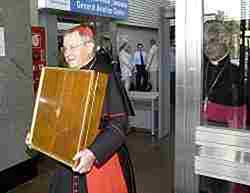
The Icon remained covered despite the request of Moscow Catholics to venerate it |
On the other hand, if the Icon is the original, why would John Paul II deliver it to the Russian Schismatic Church before Russia has converted? The return of the Icon of Kazan to the Schismatic Alexis II implies that the conversion Our Lady predicted at Fatima had taken place, that the Russian Schismatic Church is no longer in error, even if it still denies the dogmas of the Filioque, the Immaculate Conception, and Papal Infallibility.
Further, the return of the Icon would indicate that the consecration of Russia to the Immaculate Heart of Mary had been made and the Fatima message was closed. In fact, the consecration has never been made as specified by Our Lady: that is, made by the Holy Father together with all the Bishops of the world (12).
For the Catholic faithful, the Pope’s unconditional delivery of the sacred Icon of Our Lady of Kazan is nothing less than a betrayal of the Fatima message, a very serious matter.
6. “Russia Patriarch says Renowned Icon is a Copy,” Catholic World News online, August 13, 2004.
7. “Vatican charged with stealing icon: Orthodox prelate asks police help “ Catholic World Report, February 20, 2002.
8. “Russia Patriarch Says Renowned Icon is a Copy,” ibid.
9. Steve Gutterman, “Russian Orthodox Leader Snubs Pontiff,” Guardian Unlimited online, August 13, 2004.
10. A S. Guimarães, The End of the Story, "View of the News,” August 16, 2004.
11. “Orthodox Church hopes for More Meetings in Moscow and Rome after Icon’s Return,” Asia News online, September 1, 2004.
12. Fr. Paul Kramer, The Devil’s Final Battle (Terryville, CT: The Missionary Ass., n.d.), pp. 263-84.
A betrayal of the Church’s honor and reputation
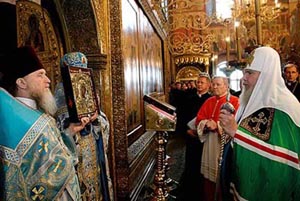
Alexis II and Kasper, at right, during the hand-over in the Kremlin’s cathedral |
As the hand-over progressed, two contrary lines of action developed. The Vatican used the occasion to proclaim it a historic event, a first step toward establishing brotherly relations, a symbol of the unity of East and West. The Russian Schismatics, on the contrary, took every opportunity to downplay the event, stress the difficulties, and air old grievances.
Along the way of the handover, the Vatican had to bear a string of insults from the Russian Schismatics. To begin with, the day before the hand-over of the icon, Alexis II gave an interview to the Italian newspaper Corriere della Sera in which he condemned the Catholic Church for “proselytism” and renewed his criticisms of the Holy See (13). The Vatican swallowed the offense.
On the overnight stopover in Moscow, Russian Catholics asked permission to pray before the icon. But Vatican officials, fearful of an outburst from Alexis, refused, saying that it would be “rude” if anyone were allowed to see it before the Schismatic Patriarch. So the Icon stayed covered until its handover at the Kremlin’s Cathedral of the Dormition the next day (14).
On August 28, during the handing off at the end of the ceremony, Alexis could not refrain from rebuking the Catholics for establishing four new Catholic Dioceses in Russia four years ago: “We are grateful to the Pope, and we hope that Catholics and Orthodox won’t be competitors in Russia.” Even the Vatican delegation seemed taken back when he added “I hope this demonstrates a desire on the part of the Vatican to seriously return to an attitude of respect with regard to our church” (15).
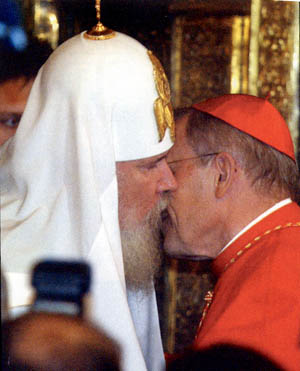
A perfunctory kiss during the handing over ceremony
Inside the Vatican, September 2004 |
After the ceremony, Alexis II told the media that the Icon had taught many Catholics to love the Russian “Orthodox” Church and its cultural heritage. The audacity of the remark leaves one wordless. The Vatican handed over a precious Icon, no strings attached, and the response is that the fortunate ones are the Catholics because they learned to love a heretical sect…
A reporter asked a final question: Any possibility for a papal visit in Russia now? The curt reply: “At the moment, impossible” (16) The same arrogant refusal, the same rude attitude. So much for the “new” climate supposedly created by the gift.
The “Letter of Gratitude” to the Pope sent from Moscow on August 31 was not without its gibes. Alexis II remarked that “the transfer of this holy Icon” was seen as “an act of justice” as well as an act of good will. He ended the letter with a veiled threat that any openness in relations will rely on the Vatican’s commitment to cease and desist any conversion efforts in Russia (17). Hardly a sign of ecumenical reciprocity.
If the past has lessons for the future, we should realize that doing something nice for the officials of the Schismatic Church results in greater hostility, not less. To date, the many Vatican concessions in the name of dialogue and communion have been repaid with disdain and open slaps in the face. Accepting one insult after another goes far beyond the proverbial turning of the cheek. Rather, in the name of its failed ecumenism, the Vatican is betraying the very honor and reputation of the Holy Church.
13. “Russian Orthodox Patriarch Alexy II Blasts Vatican ‘proselytism’ (as pope returns icon),” Free Republic online, August 27, 2004.
14. “Patriarch Should be First to see the Icon of Kazan,” Asia News online, August 25, 2004.
15. “Icon returned to Russian Church,” Vatican Post online, August 28, 2004; Aleksij II: Orthodox and Catholics together against secularization, Asia News online, August29, 2004.
16. “Orthodox and Catholics together against secularization,” ibid, August 29, 2004.
17. “Patriarch Alexy II sends Letter of Gratitude to Pope,” Zenit News Agency, August 31, 2004.

Posted October 18, 2004
|

Related Topic of Interest
 Has the Fatima Promise Been Fulfilled? Has the Fatima Promise Been Fulfilled?
Follow the controversy

Ecumenism | Hot Topics | Home | Books | CDs | Search | Contact Us | Donate
 © 2002-
Tradition in Action, Inc. All Rights Reserved
© 2002-
Tradition in Action, Inc. All Rights Reserved
|
 |
|